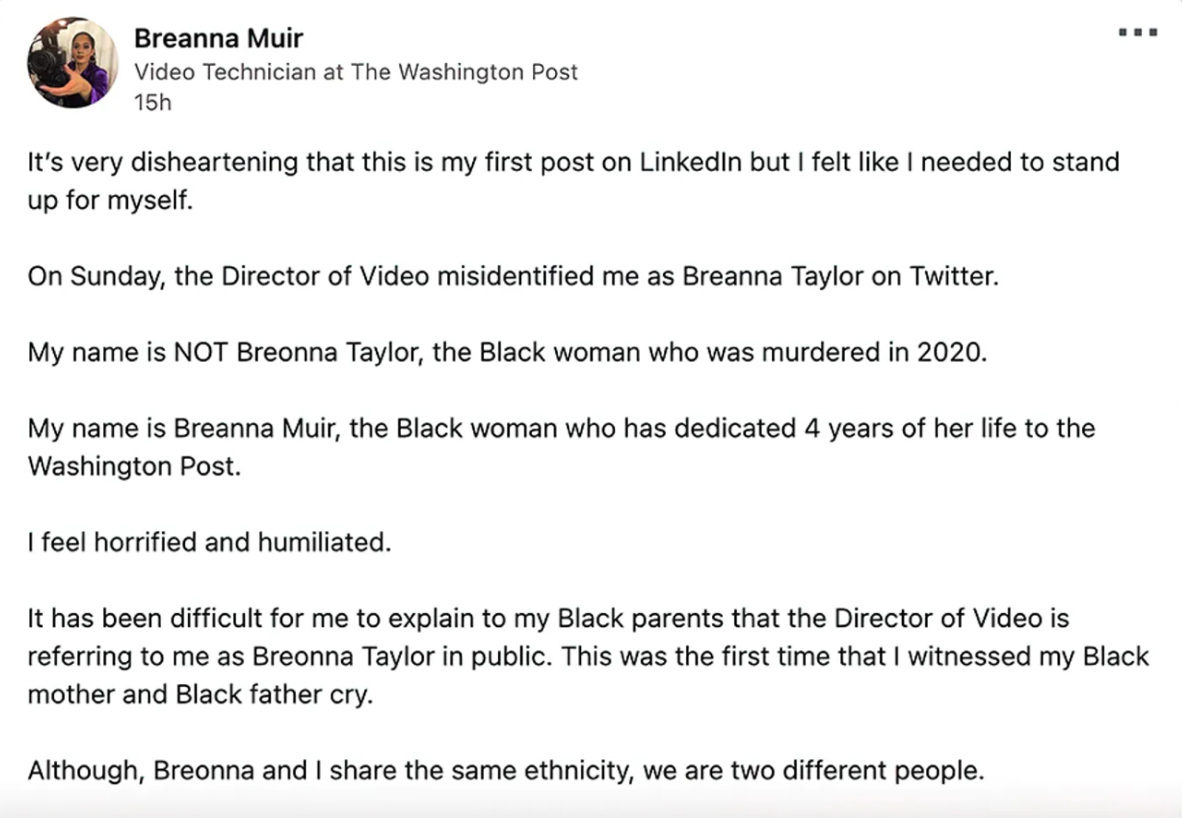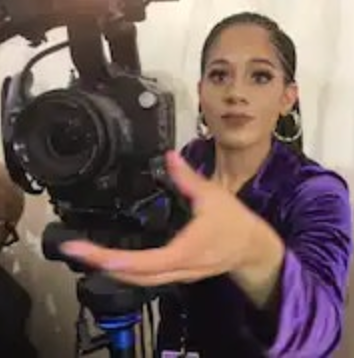
A Washington Post video technician says she was left distraught after a senior newsroom editor wrongly identified her as slain Kentucky woman Breonna Taylor on Twitter.
Breanna Muir called on workplace executives to “stop misidentifying people of colour” after The Post’s director of photography Micah Gelman confused her with Ms Taylor, who was shot dead by police as they executed a no-knock search warrant in Louisville in March 2020.
Mr Gelman had been paying tribute to video staff for their tireless work covering the Ukraine invasion in a lengthy Twitter thread on Sunday when he mistakenly referred to Ms Muir by Ms Taylor’s name.
Mr Gelman later deleted the tweet and issued an apology, saying he had also attempted to reach Ms Muir privately to apologise.
“We are all working extremely long hours and while this was not intentional, it should not have happened,” he said.


Responding on LinkedIn, Ms Muir said she was left “horrified and humiliated”, and that the incident had caused her parents to cry.
“It’s very disheartening that this is my first post on LinkedIn but I felt like I needed to stand up for myself,” Ms Muir wrote in the post.
“My name is NOT Breonna Taylor, the Black woman who was murdered in 2020. My name is Breanna Muir, the Black woman who has dedicated 4 years of her life to the Washington Post,” Ms Muir continued.
“It has been difficult for me to explain to my Black parents that the Director of Video is referring to me as Breonna Taylor in public. This was the first time that I witnessed my Black mother and Black father cry.

“Although, Breonna and I share the same ethnicity, we are two different people,” she wrote.
“It is not okay and I’m not okay. I pray that these type of ‘mix-ups’ never happen to anyone.”
The post included a screenshot of Mr Gelman’s offensive tweet along with several hashtags including washingtonpost, jezzbezos and blacklivesmatter.
Colleagues at the Post voiced their support for Ms Muir and anger at Mr Gelman’s comments.
National politics reporter Felicia Sonmez described the post as “racist” and said she was “still flabbergasted” at how the director of video could “call a member of his own team ‘Breanna Taylor’ instead of her actual name” on Twitter.
She shared Mr Muir’s LinkedIn post and said her colleague was “wisely” not on Twitter, adding that her own vocal support of her colleague had attracted racist and sexist abuse on the platform.
Hours after Mr Gelman issued an apology, Ms Sonmez tweeted a link to a Substack blog written by Emma Rose Fox which stated: “The racist treatment of Washington Post video technician Breanna Muir illustrates a wider, systematic problem.”
In a statement to The Independent, the Post’s Chief Communications Officer Kris Coratti said: “Our director of video has apologised both publicly and privately for his mistake.
“However, we do not take the impact of that error lightly and regret the emotional toll it has had on Breanna. We have also reached out to her and are committed to fostering an inclusive environment throughout the newsroom.”
Ms Taylor’s death in 2020 set off a wave of national outrage, which intensified after the death of George Floyd a few months later.
Louisville Metro Police Detective Brett Hankison is currently on trial facing three charges of wanton endangerment over accusations he fired recklessly during the March 2020 raid. He is the sole law enforcement officer to face criminal charges stemming from the shooting.
The Post also faced an upheaval in 2019 when star reporter Wesley Lowery was reprimanded for violating the paper’s social media policy over tweets about racism.
Former executive editor Marty Baron threatened to fire Mr Lowery after he criticised the New York Times for failing to note the underlying racism between the Tea Party movement.
Mr Lowery was critical with how the Post handled issues of race under Mr Baron’s leadership when he left the paper in January 2020.
In a now-deleted tweet, Mr Lowery said: “Should go without saying: reporters of color shouldn’t have their jobs threatened for speaking out about mainstream media failures to properly cover and contextualize issues of race. What’s the point of bringing diverse experiences and voices into a room only to muzzle them?”







